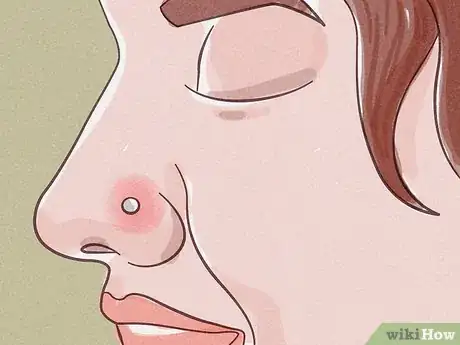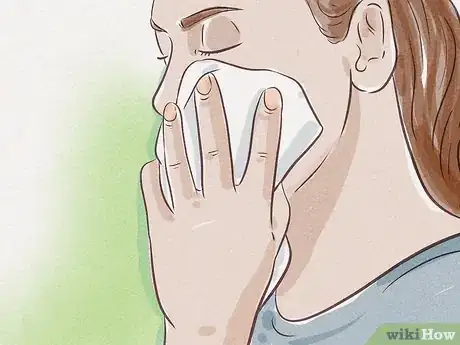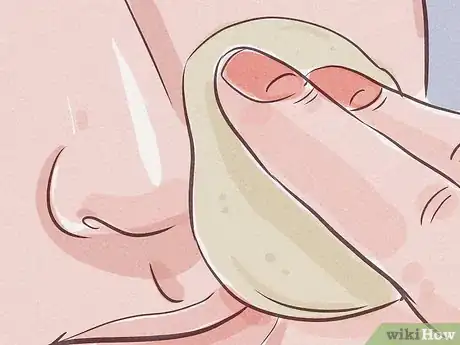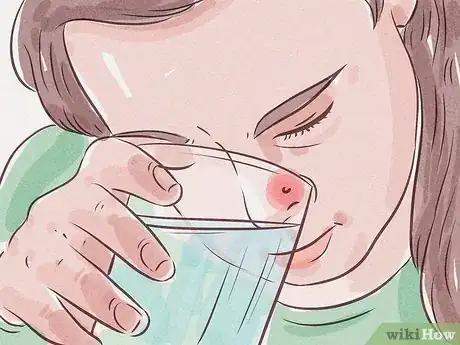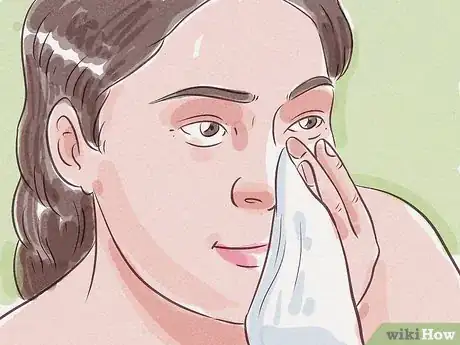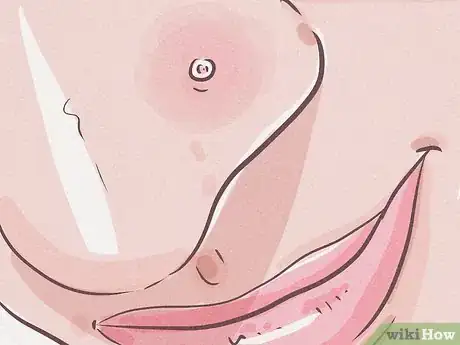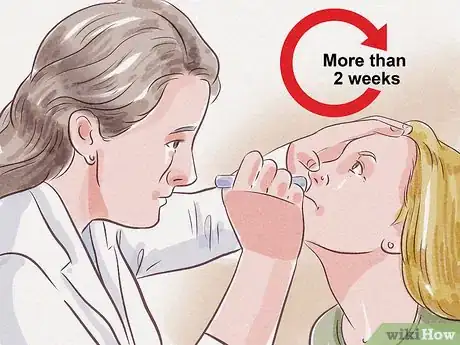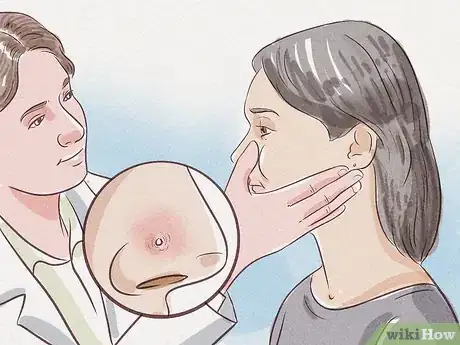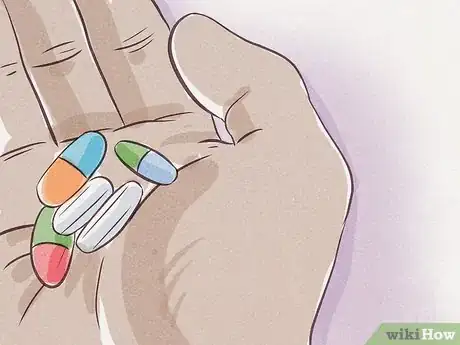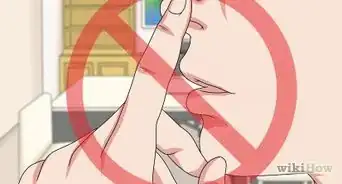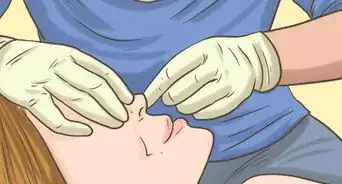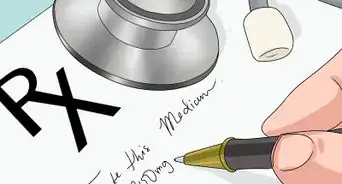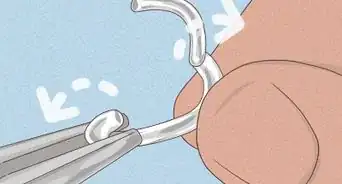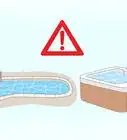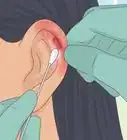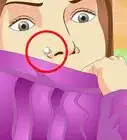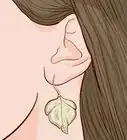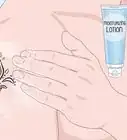This article was medically reviewed by Luba Lee, FNP-BC, MS and by wikiHow staff writer, Danielle Blinka, MA, MPA. Luba Lee, FNP-BC is a Board-Certified Family Nurse Practitioner (FNP) and educator in Tennessee with over a decade of clinical experience. Luba has certifications in Pediatric Advanced Life Support (PALS), Emergency Medicine, Advanced Cardiac Life Support (ACLS), Team Building, and Critical Care Nursing. She received her Master of Science in Nursing (MSN) from the University of Tennessee in 2006.
There are 10 references cited in this article, which can be found at the bottom of the page.
wikiHow marks an article as reader-approved once it receives enough positive feedback. This article received 13 testimonials and 88% of readers who voted found it helpful, earning it our reader-approved status.
This article has been viewed 2,261,981 times.
Nose piercings are one of the most common facial piercings. Generally, they’re quite easy to keep clean, but any piercing can become infected. Luckily, infected nose piercings are easy to treat. If you suspect an infection, you can try at-home treatment options, but you may find it necessary to seek medical care. After treatment, you’ll want to take steps to prevent reinfection and keep your nose healthy!
Steps
Using Home Treatment
-
1Look for symptoms of infection. If you think you have an infection, you should visit your doctor. Left untreated, an infection could quickly become serious. Although there are treatments you can try at home, it's best to seek medical attention when you suspect an infection. Symptoms of an infection include:[1]
- Fever
- Redness
- Swollen skin around the piercing
- Pain or tenderness
- Yellow or green discharge from the piercing site
-
2Apply a warm compress if there’s swelling. A warm compress can help relieve swelling by draining away the fluid. You can make a compress by soaking a clean rag in warm water and then laying it over the area. Hold the rag in place, applying gentle pressure to the site.[2]
- Don’t press down too hard. If you feel any pain from the light pressure, stop using the warm compress and talk to your doctor.
- Make sure that you leave enough of a gap under the rag for you to breathe comfortably.
- The warm compress also softens any discharge so that it can be wiped away.
Advertisement -
3Wash the piercing 3 or 4 times a day while it’s infected. After washing your hands, use soap and warm water to cleanse the piercing area. Afterwards, blot the area dry with a clean, dry cloth.[3]
- You may want to use a disposable paper towel or napkin to make sure that the cloth does not harbor germs or bacteria.
- You can use a sea salt solution instead of soap for a natural antiseptic.
-
4Use a sea salt solution to cleanse the piercing as an alternative to soap. A sea salt solution is a natural antiseptic that isn’t too drying. Mix about .25 teaspoons (1.2 ml) of sea salt into 1 cup (0.24 l) of warm distilled or bottled water. Hold your face over the sink with your nose pointing down. Slowly apply the sea salt solution, careful not to get any in your nostrils.[4]
- If you are using a spray bottle, angle the nozzle downward as you spritz the piercing.
- If you are using a glass or dish, pour slowly so that the solution trickles down over the piercing.
- Use only sea salt, never table salt, which contains iodine.
- The best time to do this is after you take a shower or bath.[5]
- Rubbing alcohol and hydrogen peroxide are not recommended for use on piercings, as they make it harder for skin to heal. Unless a doctor tells you to use them, stick to soap and water.[6]
-
5Remove any dry pieces of skin or debris from around the area. After you wash the area, look for dry pieces of skin or discharge that are around the piercing. It’s best to do this while the skin is still wet, which minimizes the chance of damaging the skin or causing tears around the piercing. Gently wipe away the dry pieces or debris using a clean cloth.[7]
-
6Leave your piercing in your nose even if it's infected. Nose piercings close very quickly, which means that the infection cannot drain.[8] Keeping your piercing in will allow the infection and discharge to drain through the piercing, preventing buildup that could become an abscess.[9]
- Always follow your doctor’s instructions. If they believe the piercing should come out, then remove the nose ring.
-
7See a doctor if symptoms continue for more than 2 weeks. Sometimes people experience just one or two symptoms of infection that they hope will go away with proper at-home cleaning. If these symptoms remain after 2 weeks, you should see a doctor immediately. Medical treatment may be necessary to fight the infection.[10]
- Nose piercing infections can become very serious, even life threatening. They can also lead to disfigurement.
- Staph infections are a huge risk with nose piercings, as staphylococcus naturally occurs inside the nose.These infections can quickly become dangerous.[11]
Seeking Medical Attention
-
1See a doctor if you're experiencing strange or unusual symptoms. If you suspect your nose piercing is infected, it’s best to see a doctor right away. However, there are times when it’s absolutely essential that you seek medical care right away to prevent further complications. If you experience any of the following symptoms, call your doctor immediately or visit an urgent care clinic:[12]
- Severe pain around the piercing.
- Throbbing or burning sensation around the area.
- Severe redness or heat near the piercing site.
- Excessive discharge that is grey, green, or yellow.
- Discharge that smells.
- High fever with dizziness, confusion, or nausea.
-
2Use an antibiotic to treat the infection. Bacterial infections are the biggest threat with nose piercings, so your doctor will likely prescribe an antibiotic. A cream can be used to treat minor infections, but an oral medication may be necessary for a more serious infection.[13]
- Follow all of your doctor's instructions.
-
3Use your antibiotic for the length of time prescribed by your doctor. Even if symptoms improve, continue to use your antibiotic for the entire treatment window. Your doctor will tell you for how long you need to apply or take the medication.
- If you discontinue use early, the infection could come back stronger.[14]
-
4Get immediate care for an abscess. An abscess is a buildup of pus than can occur around the piercing site. Not only is it a health risk, but it could also lead to scarring. Ask your doctor for an appointment that day, or visit an urgent care clinic. The doctor will likely prescribe an antibiotic and determine if the abscess can drain on its own.[15]
-
5Follow-up with your doctor if necessary. If your doctor recommends it or your symptoms persist, schedule a follow-up appointment. Remember, nose piercing infections can quickly turn serious, leading to health risks and disfigurement. Seeing your doctor can help you keep your nose healthy.
Preventing Reinfection
-
1Clean the piercing twice a day to limit infection risks. Wash your hands with soap and warm water before cleansing the piercing. You can simply wash the piercing with warm water or soap. Afterwards, pat it dry with a clean, dry cloth.[18]
- Wash the piercing slowly so that you don’t accidentally inhale water through your nostrils.
- Some people prefer to use a saline solution, which is a natural antiseptic. This is usually only used when the piercing is healing.
-
2Avoid applying products near the piercing. When applying face lotion, acne cream, or similar products, avoid the area around your nose piercing. These products can harbor bacteria and potentially infect the piercing. Do your best to keep the piercing as free and clear of products as possible. Products to avoid include the following:[19]
- Lotions
- SPF creams
- Acne creams
- Hair products
- Face masks
- Cleansers with fragrances or exfoliators
-
3Keep your hands off the piercing. Your fingers carry dirt, germs, and bacteria, all of which can infect the piercing, resulting in another infection. Do not touch or play with your jewelry.[20]
- If you feel tempted to touch it, loosely cover the piercing with a sterile gauze while it heals from the infection. This will help prevent reinfection.
-
4Avoid swimming until the infection is completely gone. Pools and other bodies of water are a haven of germs and bacteria, which makes them a danger to piercings. Until your nose piercing is completely healed, you should stay away from pool, hot tubs, and bodies of water, such as lakes, ponds, and oceans.[21]
- Since the piercing is on your nose, you may be tempted to go swimming but not put your head under. However, splashing and touching your face with wet hands can still reinfect the piercing, so it’s best to stay dry.
-
5Make sure your jewelry is hypoallergenic to prevent allergic reactions. An allergic reaction is not the same thing as an infection, but it can make it hard for your nose to heal properly. Not only that, but allergic infections can cause your piercing to swell and have discharge just like an infection. It’s best to use hypoallergenic jewelry to minimize your risk. Luckily, most reputable piercers already use these products.
- Check with your piercer to see if your jewelry is hypoallergenic. If you’ve already changed your nose ring to an item you bought at a store, check the packaging.
- The best metals to use include surgical steel and titanium.[22]
Expert Q&A
-
QuestionSo I've had a piercing for months and I clean it regularly. After a while, I removed it and haven't used it since. It has been 2-3 years and I have a little bump. The piercing hole is definitely closed. is there a way to treat this to make the bump disappear even after I haven't used the piercing for a couple of years ?
 Luba Lee, FNP-BC, MSLuba Lee, FNP-BC is a Board-Certified Family Nurse Practitioner (FNP) and educator in Tennessee with over a decade of clinical experience. Luba has certifications in Pediatric Advanced Life Support (PALS), Emergency Medicine, Advanced Cardiac Life Support (ACLS), Team Building, and Critical Care Nursing. She received her Master of Science in Nursing (MSN) from the University of Tennessee in 2006.
Luba Lee, FNP-BC, MSLuba Lee, FNP-BC is a Board-Certified Family Nurse Practitioner (FNP) and educator in Tennessee with over a decade of clinical experience. Luba has certifications in Pediatric Advanced Life Support (PALS), Emergency Medicine, Advanced Cardiac Life Support (ACLS), Team Building, and Critical Care Nursing. She received her Master of Science in Nursing (MSN) from the University of Tennessee in 2006.
Board-Certified Family Nurse Practitioner It sounds like the bump you are describing is a scar tissue and it might get slightly smaller over time, but it is unlikely that it will ever disappear.
It sounds like the bump you are describing is a scar tissue and it might get slightly smaller over time, but it is unlikely that it will ever disappear. -
QuestionCan I use table salt for the salt solution, as I do not have sea salt?
 Luba Lee, FNP-BC, MSLuba Lee, FNP-BC is a Board-Certified Family Nurse Practitioner (FNP) and educator in Tennessee with over a decade of clinical experience. Luba has certifications in Pediatric Advanced Life Support (PALS), Emergency Medicine, Advanced Cardiac Life Support (ACLS), Team Building, and Critical Care Nursing. She received her Master of Science in Nursing (MSN) from the University of Tennessee in 2006.
Luba Lee, FNP-BC, MSLuba Lee, FNP-BC is a Board-Certified Family Nurse Practitioner (FNP) and educator in Tennessee with over a decade of clinical experience. Luba has certifications in Pediatric Advanced Life Support (PALS), Emergency Medicine, Advanced Cardiac Life Support (ACLS), Team Building, and Critical Care Nursing. She received her Master of Science in Nursing (MSN) from the University of Tennessee in 2006.
Board-Certified Family Nurse Practitioner Table salt has iodine which might be too irritating to some people compared to iodine-free salt.
Table salt has iodine which might be too irritating to some people compared to iodine-free salt.
Warnings
- Use sea salt only, not table salt, as it contains iodine, which is an irritant.⧼thumbs_response⧽
- Nose piercing infections can quickly become serious if not treated by a physician.⧼thumbs_response⧽
- Over-the-counter antiseptics are too strong for the delicate skin around your nose, so avoid using them.⧼thumbs_response⧽
References
- ↑ https://www.nhs.uk/conditions/body-piercing/#Self-care
- ↑ https://www.medicalnewstoday.com/articles/319999.php
- ↑ https://www.webmd.com/skin-problems-and-treatments/tc/body-piercing-problems-home-treatment#1
- ↑ https://www.medicalnewstoday.com/articles/319999.php
- ↑ https://www.nhs.uk/conditions/body-piercing/#Self-care
- ↑ https://uhs.berkeley.edu/health-topics/body-piercings
- ↑ https://uhs.berkeley.edu/health-topics/body-piercings
- ↑ https://www.medicalnewstoday.com/articles/319999.php
- ↑ https://www.nhs.uk/conditions/body-piercing/#Getting-medical-help
- ↑ https://www.medicalnewstoday.com/articles/319999.php
- ↑ https://www.aafp.org/afp/2005/1115/p2029.html
- ↑ https://www.medicalnewstoday.com/articles/319999.php
- ↑ https://www.nhs.uk/conditions/body-piercing/#Self-care
- ↑ https://www.nhs.uk/conditions/body-piercing/#Self-care
- ↑ https://www.nhs.uk/conditions/body-piercing/#Self-care
- ↑ https://www.webmd.com/a-to-z-guides/abscess#2
- ↑ https://www.webmd.com/a-to-z-guides/abscess#3
- ↑ https://www.mayoclinic.org/healthy-lifestyle/adult-health/in-depth/piercings/art-20047317?pg=2
- ↑ https://www.medicalnewstoday.com/articles/319999.php
- ↑ https://www.mayoclinic.org/healthy-lifestyle/adult-health/in-depth/piercings/art-20047317?pg=2
- ↑ https://www.mayoclinic.org/healthy-lifestyle/adult-health/in-depth/piercings/art-20047317?pg=2
- ↑ https://www.medicalnewstoday.com/articles/319999.php
- ↑ https://www.nhs.uk/chq/Pages/1770.aspx
About This Article
If you notice symptoms, like fever, redness, or tenderness, you may have an infected nose piercing and need to visit your doctor. To treat your infection at home, apply a warm compress to your nose with gentle pressure, so it can relieve some of the swelling. You should also make sure to remove any dried pieces of skin or debris from around the area, as well as wipe away any discharge you notice. As long as your nose piercing is infected, you should wash the area 3 or 4 times a day with either soap and warm water or a sea salt solution, which can serve as a natural antiseptic. Because nose piercings close very quickly, do not remove your piercing unless your doctor recommends it, or your nose could develop an abscess. For more tips from our Medical co-author, including how to prevent your nose piercing from becoming infected, keep reading!
